1999 FORD MUSTANG tire pressure
[x] Cancel search: tire pressurePage 119 of 216

Fuse/Relay
LocationFuse Amp
RatingDescription
9 20A** Auxiliary Power Point
10 30A** Parklamps
11 30A** Rear Window Defrost
Control
12 40A** Power Windows, Power
Locks
13 Ð Not Used
14 20A* Fuel Pump
15 10A* Radio
16 20A* Horn
17 20A* Anti-Lock Brake System
18 25A* Power Seats
19 Ð Not Used
20 20A* Generator
21 Ð Not Used
22 Ð Not Used
23 Ð Not Used
24 20A* A/C Pressure (3.8L
only)
25 Ð Not Used
26 30A** PCM
27 20A** DRL Module, Foglamp
Relay
28 25A CB Convertible Top
* Mini Fuses ** Maxi Fuses
CHANGING THE TIRES
If you get a flat tire while driving, do not apply the
brake heavily. Instead, gradually decrease your
speed. Hold the steering wheel firmly and slowly
move to a safe place on the side of the road.
Roadside emergencies
119
Page 123 of 216
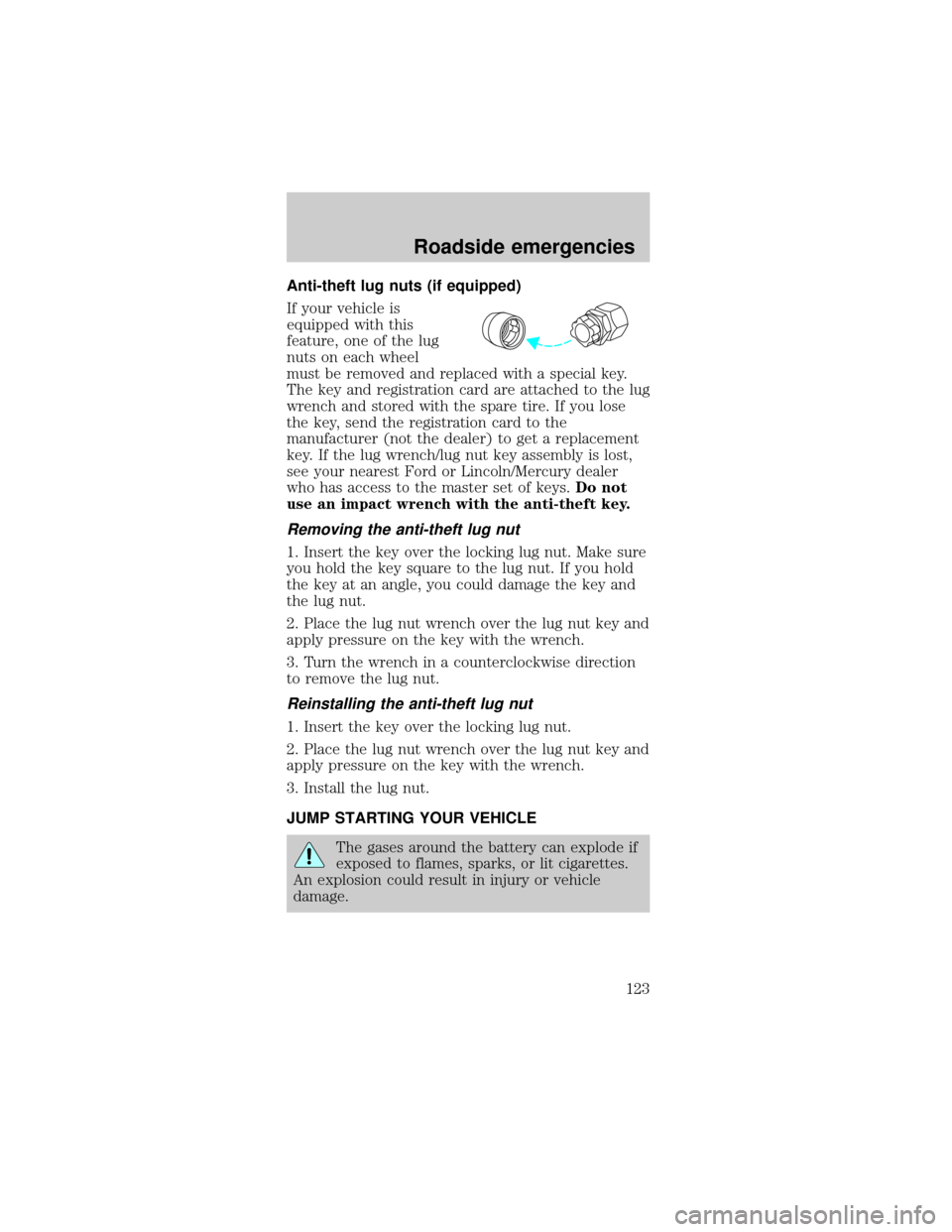
Anti-theft lug nuts (if equipped)
If your vehicle is
equipped with this
feature, one of the lug
nuts on each wheel
must be removed and replaced with a special key.
The key and registration card are attached to the lug
wrench and stored with the spare tire. If you lose
the key, send the registration card to the
manufacturer (not the dealer) to get a replacement
key. If the lug wrench/lug nut key assembly is lost,
see your nearest Ford or Lincoln/Mercury dealer
who has access to the master set of keys.Do not
use an impact wrench with the anti-theft key.
Removing the anti-theft lug nut
1. Insert the key over the locking lug nut. Make sure
you hold the key square to the lug nut. If you hold
the key at an angle, you could damage the key and
the lug nut.
2. Place the lug nut wrench over the lug nut key and
apply pressure on the key with the wrench.
3. Turn the wrench in a counterclockwise direction
to remove the lug nut.
Reinstalling the anti-theft lug nut
1. Insert the key over the locking lug nut.
2. Place the lug nut wrench over the lug nut key and
apply pressure on the key with the wrench.
3. Install the lug nut.
JUMP STARTING YOUR VEHICLE
The gases around the battery can explode if
exposed to flames, sparks, or lit cigarettes.
An explosion could result in injury or vehicle
damage.
Roadside emergencies
123
Page 155 of 216
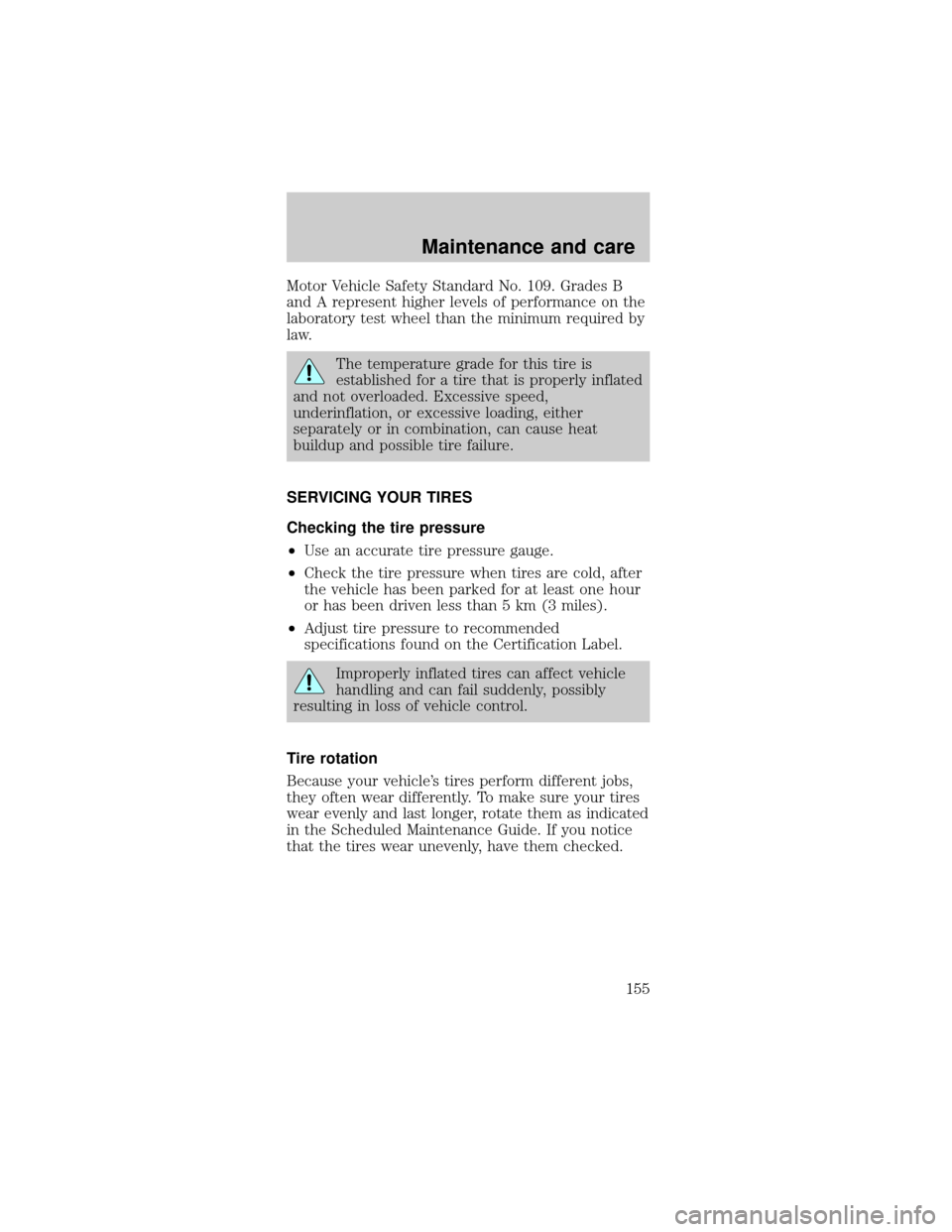
Motor Vehicle Safety Standard No. 109. Grades B
and A represent higher levels of performance on the
laboratory test wheel than the minimum required by
law.
The temperature grade for this tire is
established for a tire that is properly inflated
and not overloaded. Excessive speed,
underinflation, or excessive loading, either
separately or in combination, can cause heat
buildup and possible tire failure.
SERVICING YOUR TIRES
Checking the tire pressure
²Use an accurate tire pressure gauge.
²Check the tire pressure when tires are cold, after
the vehicle has been parked for at least one hour
or has been driven less than 5 km (3 miles).
²Adjust tire pressure to recommended
specifications found on the Certification Label.
Improperly inflated tires can affect vehicle
handling and can fail suddenly, possibly
resulting in loss of vehicle control.
Tire rotation
Because your vehicle's tires perform different jobs,
they often wear differently. To make sure your tires
wear evenly and last longer, rotate them as indicated
in the Scheduled Maintenance Guide. If you notice
that the tires wear unevenly, have them checked.
Maintenance and care
155
Page 158 of 216
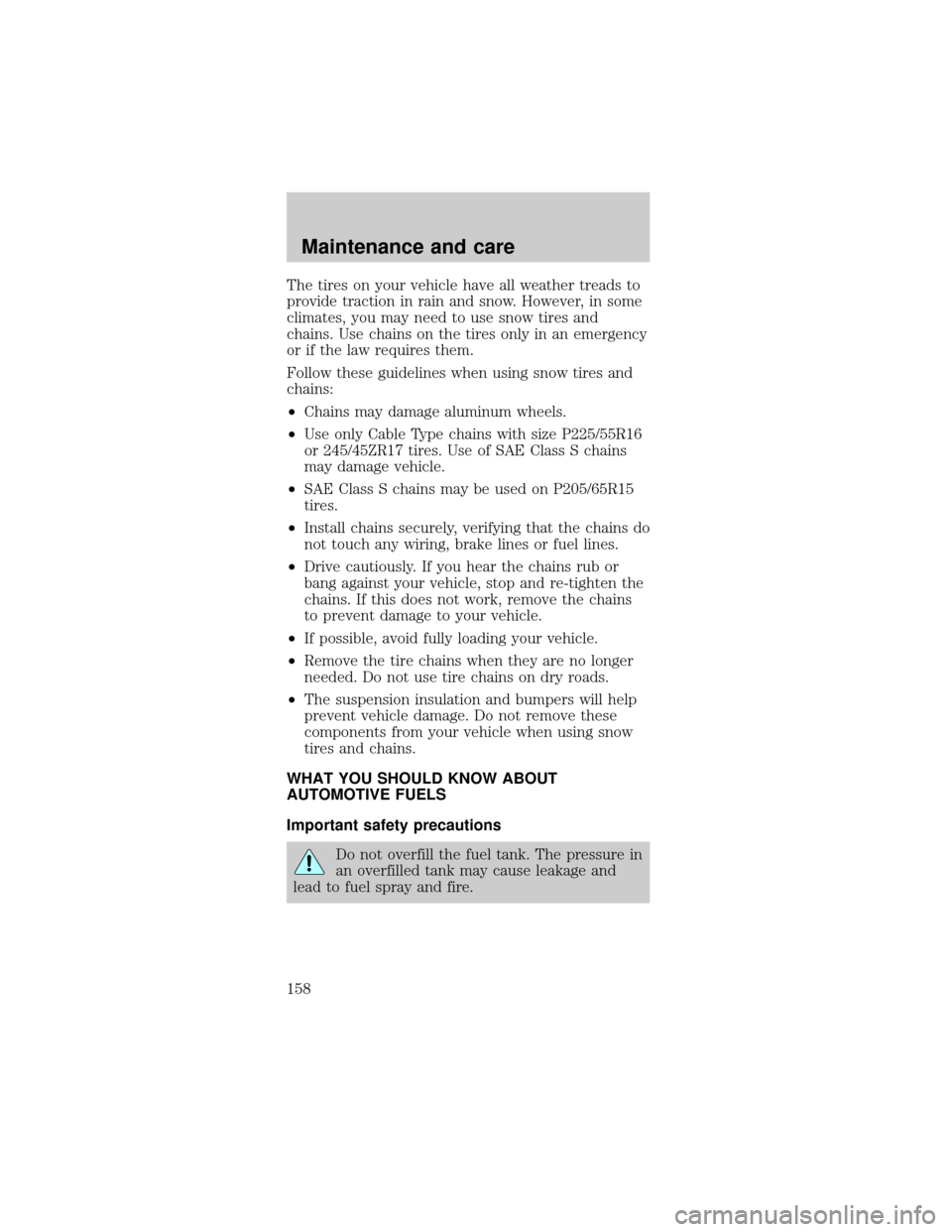
The tires on your vehicle have all weather treads to
provide traction in rain and snow. However, in some
climates, you may need to use snow tires and
chains. Use chains on the tires only in an emergency
or if the law requires them.
Follow these guidelines when using snow tires and
chains:
²Chains may damage aluminum wheels.
²Use only Cable Type chains with size P225/55R16
or 245/45ZR17 tires. Use of SAE Class S chains
may damage vehicle.
²SAE Class S chains may be used on P205/65R15
tires.
²Install chains securely, verifying that the chains do
not touch any wiring, brake lines or fuel lines.
²Drive cautiously. If you hear the chains rub or
bang against your vehicle, stop and re-tighten the
chains. If this does not work, remove the chains
to prevent damage to your vehicle.
²If possible, avoid fully loading your vehicle.
²Remove the tire chains when they are no longer
needed. Do not use tire chains on dry roads.
²The suspension insulation and bumpers will help
prevent vehicle damage. Do not remove these
components from your vehicle when using snow
tires and chains.
WHAT YOU SHOULD KNOW ABOUT
AUTOMOTIVE FUELS
Important safety precautions
Do not overfill the fuel tank. The pressure in
an overfilled tank may cause leakage and
lead to fuel spray and fire.
Maintenance and care
158
Page 167 of 216

²Combine errands and minimize stop-and-go
driving.
Maintenance
²Keep tires properly inflated and use only
recommended size.
²Operating a vehicle with the wheels out of
alignment will reduce fuel economy.
²Use recommended engine oil. Refer toLubricant
Specifications.
²Perform all regularly scheduled maintenance
items. Follow the recommended maintenance
schedule and owner maintenance checks found in
your vehicle Scheduled Maintenance Guide.
Conditions
²Heavily loading a vehicle or towing a trailer may
reduce fuel economy at any speed.
²Carrying unnecessary weight may reduce fuel
economy (approximately 2 km/h [1 mpg] is lost
for every 180 kg [400 lb] of weight carried).
²Adding certain accessories to your vehicle (for
example bug deflectors, rollover/light bars,
running boards, ski/luggage racks) may reduce
fuel economy.
²Using fuel blended with alcohol may lower fuel
economy.
²Fuel economy may decrease with lower
temperatures during the first 12±16 km (8±10
miles) of driving.
²Driving on flat terrain offers improved fuel
economy as compared to driving on hilly terrain.
²Transmissions give their best fuel economy when
operated in the top cruise gear and with steady
pressure on the gas pedal.
²Close windows for high speed driving.
Maintenance and care
167
Page 190 of 216
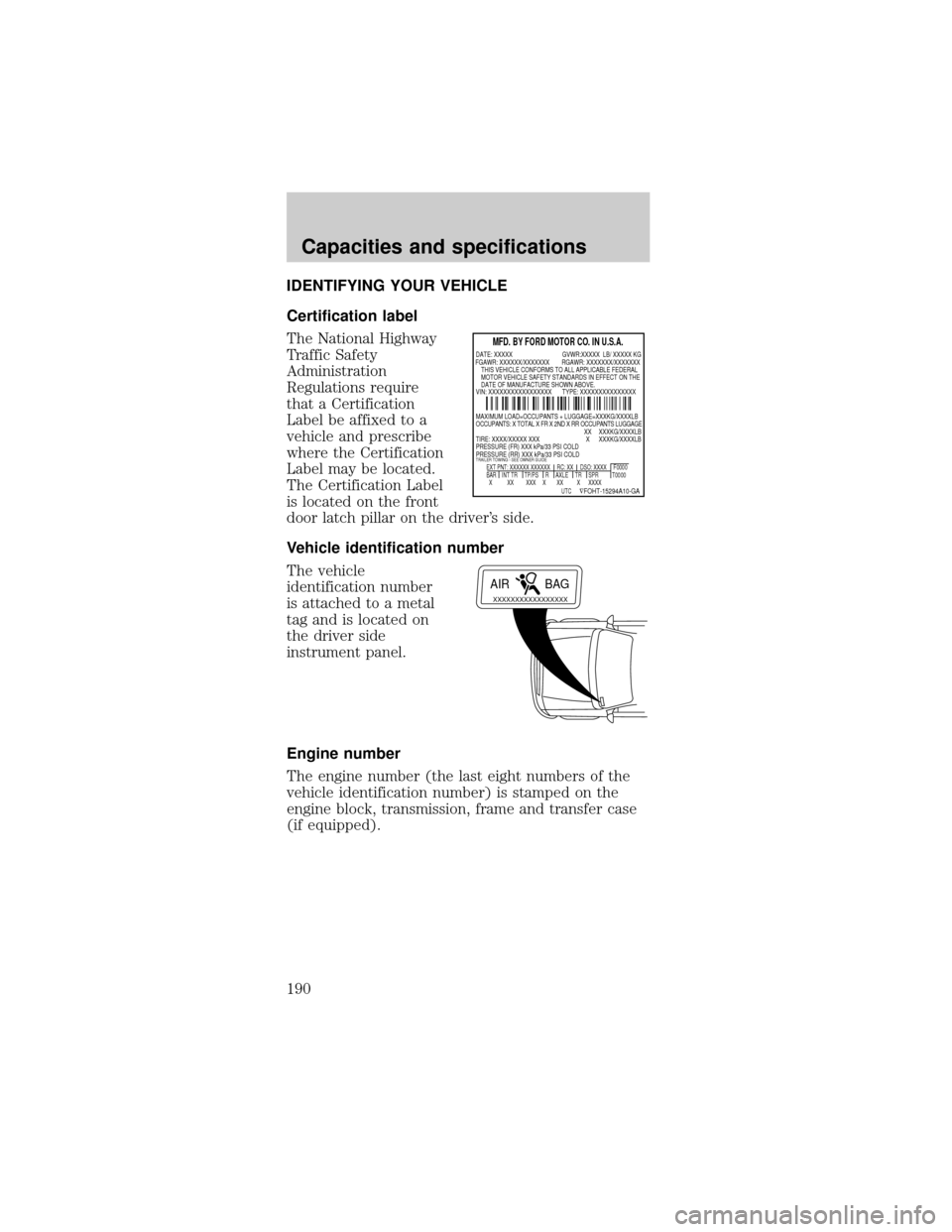
IDENTIFYING YOUR VEHICLE
Certification label
The National Highway
Traffic Safety
Administration
Regulations require
that a Certification
Label be affixed to a
vehicle and prescribe
where the Certification
Label may be located.
The Certification Label
is located on the front
door latch pillar on the driver's side.
Vehicle identification number
The vehicle
identification number
is attached to a metal
tag and is located on
the driver side
instrument panel.
Engine number
The engine number (the last eight numbers of the
vehicle identification number) is stamped on the
engine block, transmission, frame and transfer case
(if equipped).
MFD. BY FORD MOTOR CO. IN U.S.A.
EXT PNT: XXXXXX XXXXXX RC: XX DSO: XXXX F0000
BAR INT TR TP/PS R AXLE TR SPR T0000
X XX XXX X XX X XXXX
UTC
ÑFOHT-15294A10-GA
MAXIMUM LOAD=OCCUPANTS + LUGGAGE=XXXKG/XXXXLB
OCCUPANTS: X TOTAL X FR X 2ND X RR OCCUPANTS LUGGAGE
XX XXXKG/XXXXLB
TIRE: XXXX/XXXXX XXX X XXXKG/XXXXLB
PRESSURE (FR) XXX kPa/33 PSI COLD
PRESSURE (RR) XXX kPa/33 PSI COLD
TRAILER TOWING - SEE OWNER GUIDE
DATE: XXXXX GVWR:XXXXX LB/ XXXXX KG
VIN: XXXXXXXXXXXXXXXXX TYPE: XXXXXXXXXXXXXXX FGAWR: XXXXXX/XXXXXXX RGAWR: XXXXXXX/XXXXXXXTHIS VEHICLE CONFORMS TO ALL APPLICABLE FEDERAL
MOTOR VEHICLE SAFETY STANDARDS IN EFFECT ON THE
DATE OF MANUFACTURE SHOWN ABOVE.
XXXXXXXXXXXXXXXXXAIR BAG
Capacities and specifications
190
Page 211 of 216

Power distribution box
(see Fuses) ............. 117
Power door locks ...... 51
Power steering .......... 96
fluid, checking
and adding ............ 144
fluid, refill
capacity ................. 183
fluid,
specifications . 185,188
Radio .......................... 21
Relays ...................... 113
Remote entry
system ................... 56,58
illuminated entry .... 58
locking/unlocking
doors ........................ 57
opening the trunk ... 58
panic alarm ............. 58
replacement/
additional
transmitters ............. 59
replacing the
batteries .................. 59
Roadside
emergencies ......... 60,62
Safety belts (see
Safety restraints) ...... 11
68,69,70,71,72
Safety Compliance
Certification Label .. 190
Safety defects,
reporting .................. 206
Safety restraints ... 68,69
70,71,72
cleaning the safety
belts .................. 73,181
extension
assembly .................. 72
for adults .. 69,70,71,72
for children ........ 79,80warning light and
chime .......... 7,11,72,73
Safety seats
for children ................ 81
Seat belts (see Safety
restraints) .................. 68
Seats .......................... 64
child safety seats .... 81
cleaning ................. 180
Seats-easy access/
easyout feature ......... 67
Servicing your
vehicle ...................... 130
Spark plugs,
specifications .... 182,188
Special notice .............. 3
Specification chart,
lubricants .......... 185,188
Speed control ............ 46
Speedometer ............. 13
Starting your
vehicle .............. 87,88,90
jump starting ........ 123
preparing to start
your vehicle ....... 60,62
Steering wheel
tilting ....................... 46
Tachometer ............... 14
Tilt steering wheel .... 46
Tires .... 119,153,154,155
changing ......... 119,120
checking the
pressure ................. 155
replacing ................ 156
rotating .................. 155
snow tires
and chains ............. 157
tire grades ............. 154
treadwear .............. 154
Towing
trailer towing ........ 108
wrecker .................. 128
Index
211
Page 215 of 216
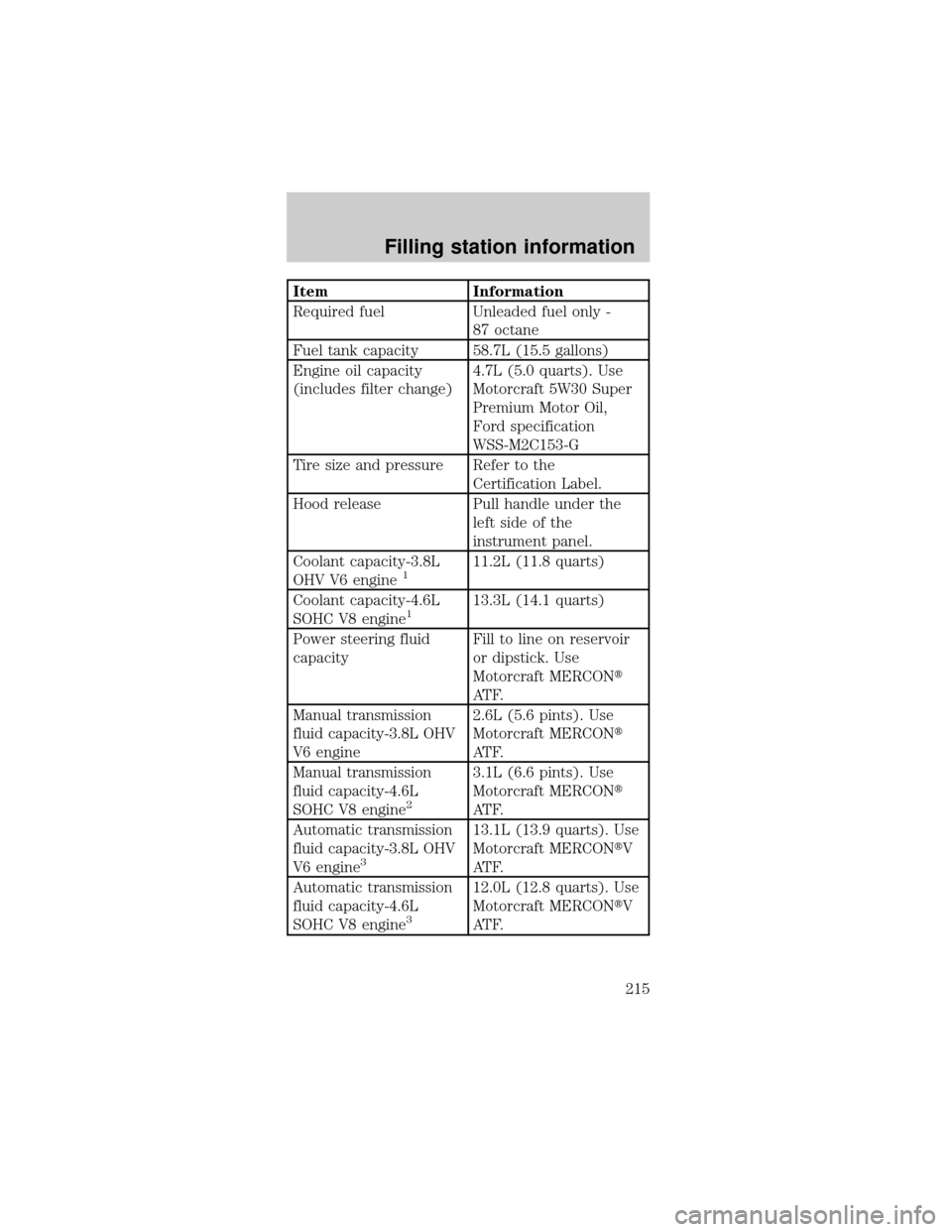
Item Information
Required fuel Unleaded fuel only -
87 octane
Fuel tank capacity 58.7L (15.5 gallons)
Engine oil capacity
(includes filter change)4.7L (5.0 quarts). Use
Motorcraft 5W30 Super
Premium Motor Oil,
Ford specification
WSS-M2C153-G
Tire size and pressure Refer to the
Certification Label.
Hood release Pull handle under the
left side of the
instrument panel.
Coolant capacity-3.8L
OHV V6 engine
111.2L (11.8 quarts)
Coolant capacity-4.6L
SOHC V8 engine
113.3L (14.1 quarts)
Power steering fluid
capacityFill to line on reservoir
or dipstick. Use
Motorcraft MERCONt
AT F.
Manual transmission
fluid capacity-3.8L OHV
V6 engine2.6L (5.6 pints). Use
Motorcraft MERCONt
AT F.
Manual transmission
fluid capacity-4.6L
SOHC V8 engine
2
3.1L (6.6 pints). Use
Motorcraft MERCONt
AT F.
Automatic transmission
fluid capacity-3.8L OHV
V6 engine
3
13.1L (13.9 quarts). Use
Motorcraft MERCONtV
AT F.
Automatic transmission
fluid capacity-4.6L
SOHC V8 engine
3
12.0L (12.8 quarts). Use
Motorcraft MERCONtV
AT F.
Filling station information
215